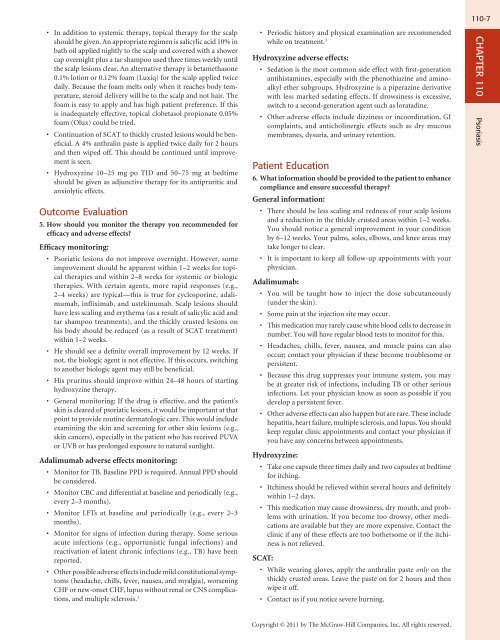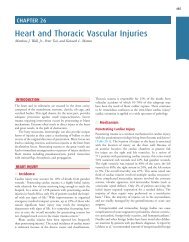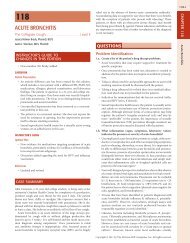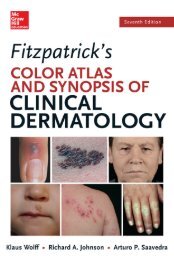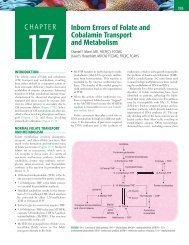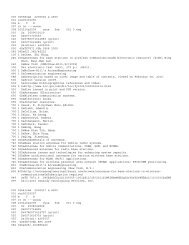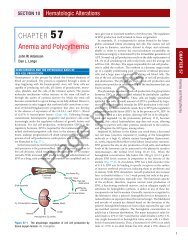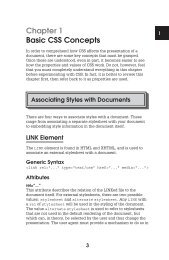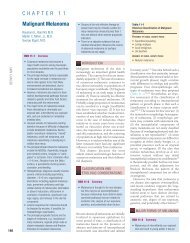PSORIASIS - McGraw-Hill Professional
PSORIASIS - McGraw-Hill Professional
PSORIASIS - McGraw-Hill Professional
Create successful ePaper yourself
Turn your PDF publications into a flip-book with our unique Google optimized e-Paper software.
110-7<br />
• In addition to systemic therapy, topical therapy for the scalp<br />
should be given. An appropriate regimen is salicylic acid 10% in<br />
bath oil applied nightly to the scalp and covered with a shower<br />
cap overnight plus a tar shampoo used three times weekly until<br />
the scalp lesions clear. An alternative therapy is betamethasone<br />
0.1% lotion or 0.12% foam (Luxiq) for the scalp applied twice<br />
daily. Because the foam melts only when it reaches body temperature,<br />
steroid delivery will be to the scalp and not hair. The<br />
foam is easy to apply and has high patient preference. If this<br />
is inadequately effective, topical clobetasol propionate 0.05%<br />
foam (Olux) could be tried.<br />
• Continuation of SCAT to thickly crusted lesions would be beneficial.<br />
A 4% anthralin paste is applied twice daily for 2 hours<br />
and then wiped off. This should be continued until improvement<br />
is seen.<br />
• Hydroxyzine 10–25 mg po TID and 50–75 mg at bedtime<br />
should be given as adjunctive therapy for its antipruritic and<br />
anxiolytic effects.<br />
Outcome Evaluation<br />
5. How should you monitor the therapy you recommended for<br />
efficacy and adverse effects?<br />
Efficacy monitoring:<br />
• Psoriatic lesions do not improve overnight. However, some<br />
improvement should be apparent within 1–2 weeks for topical<br />
therapies and within 2–8 weeks for systemic or biologic<br />
therapies. With certain agents, more rapid responses (e.g.,<br />
2–4 weeks) are typical—this is true for cyclosporine, adalimumab,<br />
infliximab, and ustekinumab. Scalp lesions should<br />
have less scaling and erythema (as a result of salicylic acid and<br />
tar shampoo treatments), and the thickly crusted lesions on<br />
his body should be reduced (as a result of SCAT treatment)<br />
within 1–2 weeks.<br />
• He should see a definite overall improvement by 12 weeks. If<br />
not, the biologic agent is not effective. If this occurs, switching<br />
to another biologic agent may still be beneficial.<br />
• His pruritus should improve within 24–48 hours of starting<br />
hydroxyzine therapy.<br />
• General monitoring: If the drug is effective, and the patient’s<br />
skin is cleared of psoriatic lesions, it would be important at that<br />
point to provide routine dermatologic care. This would include<br />
examining the skin and screening for other skin lesions (e.g.,<br />
skin cancers), especially in the patient who has received PUVA<br />
or UVB or has prolonged exposure to natural sunlight.<br />
Adalimumab adverse effects monitoring:<br />
• Monitor for TB. Baseline PPD is required. Annual PPD should<br />
be considered.<br />
• Monitor CBC and differential at baseline and periodically (e.g.,<br />
every 2–3 months).<br />
• Monitor LFTs at baseline and periodically (e.g., every 2–3<br />
months).<br />
• Monitor for signs of infection during therapy. Some serious<br />
acute infections (e.g., opportunistic fungal infections) and<br />
reactivation of latent chronic infections (e.g., TB) have been<br />
reported.<br />
• Other possible adverse effects include mild constitutional symptoms<br />
(headache, chills, fever, nausea, and myalgia), worsening<br />
CHF or new-onset CHF, lupus without renal or CNS complications,<br />
and multiple sclerosis. 3<br />
• Periodic history and physical examination are recommended<br />
while on treatment. 3<br />
Hydroxyzine adverse effects:<br />
• Sedation is the most common side effect with first-generation<br />
antihistamines, especially with the phenothiazine and aminoalkyl<br />
ether subgroups. Hydroxyzine is a piperazine derivative<br />
with less marked sedating effects. If drowsiness is excessive,<br />
switch to a second-generation agent such as loratadine.<br />
• Other adverse effects include dizziness or incoordination, GI<br />
complaints, and anticholinergic effects such as dry mucous<br />
membranes, dysuria, and urinary retention.<br />
Patient Education<br />
6. What information should be provided to the patient to enhance<br />
compliance and ensure successful therapy?<br />
General information:<br />
• There should be less scaling and redness of your scalp lesions<br />
and a reduction in the thickly crusted areas within 1–2 weeks.<br />
You should notice a general improvement in your condition<br />
by 6–12 weeks. Your palms, soles, elbows, and knee areas may<br />
take longer to clear.<br />
• It is important to keep all follow-up appointments with your<br />
physician.<br />
Adalimumab:<br />
• You will be taught how to inject the dose subcutaneously<br />
(under the skin).<br />
• Some pain at the injection site may occur.<br />
• This medication may rarely cause white blood cells to decrease in<br />
number. You will have regular blood tests to monitor for this.<br />
• Headaches, chills, fever, nausea, and muscle pains can also<br />
occur; contact your physician if these become troublesome or<br />
persistent.<br />
• Because this drug suppresses your immune system, you may<br />
be at greater risk of infections, including TB or other serious<br />
infections. Let your physician know as soon as possible if you<br />
develop a persistent fever.<br />
• Other adverse effects can also happen but are rare. These include<br />
hepatitis, heart failure, multiple sclerosis, and lupus. You should<br />
keep regular clinic appointments and contact your physician if<br />
you have any concerns between appointments.<br />
Hydroxyzine:<br />
• Take one capsule three times daily and two capsules at bedtime<br />
for itching.<br />
• Itchiness should be relieved within several hours and definitely<br />
within 1–2 days.<br />
• This medication may cause drowsiness, dry mouth, and problems<br />
with urination. If you become too drowsy, other medications<br />
are available but they are more expensive. Contact the<br />
clinic if any of these effects are too bothersome or if the itchiness<br />
is not relieved.<br />
SCAT:<br />
• While wearing gloves, apply the anthralin paste only on the<br />
thickly crusted areas. Leave the paste on for 2 hours and then<br />
wipe it off.<br />
• Contact us if you notice severe burning.<br />
CHAPTER 110<br />
Psoriasis<br />
Copyright © 2011 by The <strong>McGraw</strong>-<strong>Hill</strong> Companies, Inc. All rights reserved.


